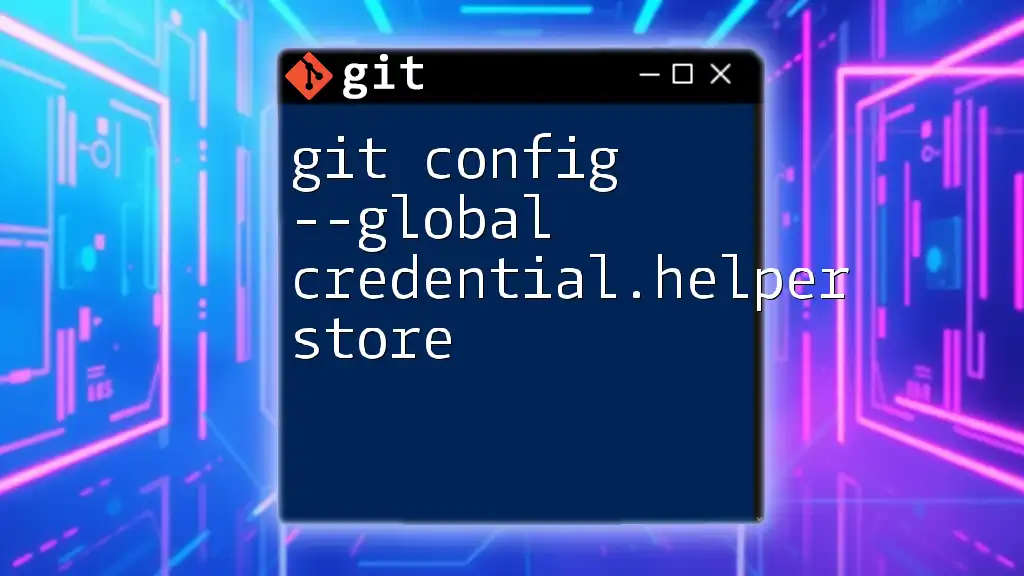The command `git config --get-all` is used to retrieve all the configuration values for a specific key in your Git environment, showing global, system, and repository-level settings if they exist.
git config --get-all user.name
What is Git Configuration?
Understanding Git Configuration
Git configuration plays a crucial role in customizing the behavior of Git to fit your workflow. Within Git, configurations can be applied at three distinct levels:
- System Level: Affects all users on the system. Typically located in the `/etc/gitconfig` file.
- Global Level: Specific to a single user. Configured in the `~/.gitconfig` file.
- Local Level: Specific to a single repository. Stored in the `.git/config` file within the repository.
By leveraging these configurations, users can personalize their Git experience, streamline their operations, and ensure consistency across environments.
Configuration Files
Git uses specific configuration files to store settings. The primary files include:
- `~/.gitconfig`: This file stores global configurations, applicable to all repositories for a given user, such as username and email.
- `.git/config`: This file contains the local configurations for a specific repository, which may override global settings.
Understanding the hierarchy of these files is essential to comprehend how values are set and retrieved, driving home the importance of organization in your Git configuration.

The `git config` Command
Understanding `git config`
The `git config` command is a powerful tool for modifying Git configuration settings. The syntax is straightforward:
git config [<options>] <key> [<value>]
Where:
- `<key>` denotes the configuration key (e.g., `user.name` or `core.editor`).
- `<value>` is the value you want to assign but is optional when retrieving settings.
Using `git config`, users can set preferences for their Git installations, making it a fundamental command in the Git toolbox.
Common Use Cases for `git config`
There are various practical applications for `git config`, such as:
-
Setting User Information: Commands like:
git config --global user.name "Your Name" git config --global user.email "you@example.com"These commands establish essential identity settings, which Git uses for committing attribution.
-
Configuring Aliases: Streamlining command entry with custom shortcuts, for example:
git config --global alias.co checkoutThis allows the user to simply type `git co` instead of `git checkout`.
-
Managing Diff and Merge Tools: Customizing the way Git handles differences and merges, making commands like:
git config --global merge.tool vimdiff

In-depth Look at `git config --get-all`
What Does `git config --get-all` Do?
The `git config --get-all` command retrieves all values associated with a specific configuration key. This command differs from `--get`, which returns only the first matching value. Using `--get-all` is especially crucial when a key can have multiple values, such as multiple remote origins for a project.
Syntax and Usage
The syntax for retrieving multiple values is as follows:
git config --get-all <key>
For example, to fetch all user email configurations, you can use:
git config --get-all user.email
This command will return all entries found in both global and local configurations for `user.email`.
Example Scenarios
Fetching Global User Email
Suppose you want to check what email addresses are set in your Git configuration. You would run:
git config --get-all user.email
If you have set multiple emails, you will see them listed one after another. This functionality allows developers to maintain separate addresses for different projects.
Retrieving Multiple Values for a Key
Another practical example is checking the remotes configured for a repository. If you've added multiple URLs for the `origin`, you can find them using:
git config --get-all remote.origin.url
This will return every URL associated with the `origin`, providing insight into your remote repositories.

Analyzing the Output of `git config --get-all`
Understanding the Output Format
The output from `git config --get-all` is typically straightforward — each value returned will appear on a new line. The results could indicate one of several things:
- If no output appears, it may signify that the key is not set within the specified configuration levels.
Understanding this output is critical for efficient troubleshooting. Users can quickly check their configurations to ensure they are set as expected.
Troubleshooting Common Issues
When using `git config --get-all`, some common issues may arise:
- No Output Returned: If running the command returns nothing, verify the appropriate configuration level. For instance, if you only check the local setting but have defined it globally, you won’t see any results.
To resolve this issue, consider checking the configuration levels individually or inspecting the corresponding configuration files directly.

Practical Applications of `git config --get-all`
Documenting Your Configuration
Keeping track of your Git configurations is vital, especially when working in teams. By using `git config --get-all`, developers can document involved settings and streamline collaboration across multiple projects. Understanding how individuals are configured can improve the consistency and predictability of team workflows.
Scripting and Automation
Incorporating `git config --get-all` into scripts can facilitate automated setups and configurations. For example, you could write a script that cleans up or reorganizes settings based on a project’s requirements:
# Example script to display all user emails
#!/bin/bash
echo "Configured User Emails:"
git config --get-all user.email
This simple script will help teams quickly audit their email configurations and modify them as needed.

Conclusion
The command `git config --get-all` is a powerful way to retrieve and manage multiple Git configuration values. Mastering this command promotes better organization and protocol adherence, ultimately aiding in the streamlined workflow of software development projects. Experimenting with this command not only enhances your comprehension of Git's capabilities but also empowers you to manage your configurations effectively.
With this knowledge, you are equipped to optimize your Git experience, so dive in and start discovering the various settings available for your workflow.

















